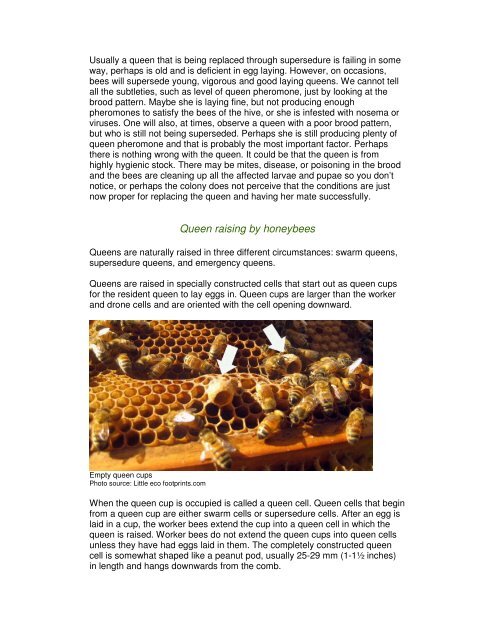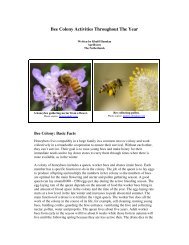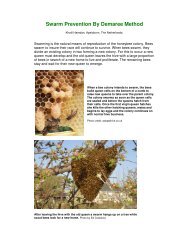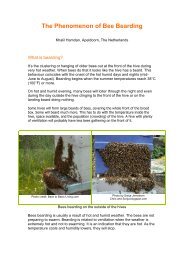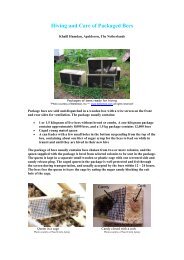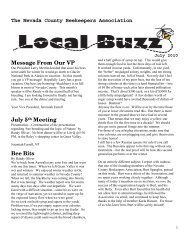Definition and reasons of supersedure
Natural Supersedure of Queens in Honey Bee ... - Country Rubes
Natural Supersedure of Queens in Honey Bee ... - Country Rubes
- No tags were found...
Create successful ePaper yourself
Turn your PDF publications into a flip-book with our unique Google optimized e-Paper software.
Usually a queen that is being replaced through <strong>supersedure</strong> is failing in some<br />
way, perhaps is old <strong>and</strong> is deficient in egg laying. However, on occasions,<br />
bees will supersede young, vigorous <strong>and</strong> good laying queens. We cannot tell<br />
all the subtleties, such as level <strong>of</strong> queen pheromone, just by looking at the<br />
brood pattern. Maybe she is laying fine, but not producing enough<br />
pheromones to satisfy the bees <strong>of</strong> the hive, or she is infested with nosema or<br />
viruses. One will also, at times, observe a queen with a poor brood pattern,<br />
but who is still not being superseded. Perhaps she is still producing plenty <strong>of</strong><br />
queen pheromone <strong>and</strong> that is probably the most important factor. Perhaps<br />
there is nothing wrong with the queen. It could be that the queen is from<br />
highly hygienic stock. There may be mites, disease, or poisoning in the brood<br />
<strong>and</strong> the bees are cleaning up all the affected larvae <strong>and</strong> pupae so you don’t<br />
notice, or perhaps the colony does not perceive that the conditions are just<br />
now proper for replacing the queen <strong>and</strong> having her mate successfully.<br />
Queen raising by honeybees<br />
Queens are naturally raised in three different circumstances: swarm queens,<br />
<strong>supersedure</strong> queens, <strong>and</strong> emergency queens.<br />
Queens are raised in specially constructed cells that start out as queen cups<br />
for the resident queen to lay eggs in. Queen cups are larger than the worker<br />
<strong>and</strong> drone cells <strong>and</strong> are oriented with the cell opening downward.<br />
Empty queen cups<br />
Photo source: Little eco footprints.com<br />
When the queen cup is occupied is called a queen cell. Queen cells that begin<br />
from a queen cup are either swarm cells or <strong>supersedure</strong> cells. After an egg is<br />
laid in a cup, the worker bees extend the cup into a queen cell in which the<br />
queen is raised. Worker bees do not extend the queen cups into queen cells<br />
unless they have had eggs laid in them. The completely constructed queen<br />
cell is somewhat shaped like a peanut pod, usually 25-29 mm (1-1½ inches)<br />
in length <strong>and</strong> hangs downwards from the comb.


